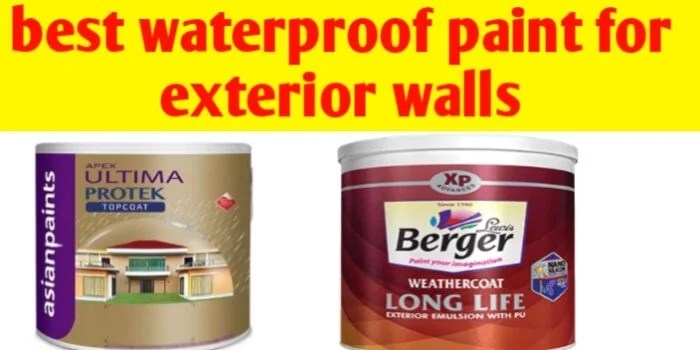Delving into the realm of home waterproofing solutions, we uncover the importance of safeguarding your home against water damage. From the different types available to common problem areas and the DIY versus professional debate, this guide offers valuable insights to help you protect your home effectively.
. Proper roof waterproofing involves regular inspection and maintenance, repairing any leaks or damaged shingles, and ensuring good drainage to prevent water accumulation.
Importance of Home Waterproofing Solutions
Home waterproofing solutions play a crucial role in maintaining the integrity and longevity of a home. By preventing water infiltration, these solutions help safeguard the structure from damage and deterioration.Consequences of Not Waterproofing a Home Properly
Failure to implement proper waterproofing measures can lead to a myriad of issues. Water intrusion can cause structural damage, mold growth, and compromise the indoor air quality of the home. Additionally, it can result in costly repairs and decrease the overall value of the property.How Waterproofing Solutions Can Protect the Structure of a Home
Waterproofing solutions create a barrier against moisture, preventing it from seeping into the walls, foundation, and other structural components of the home. By keeping water out, these solutions help maintain a dry and healthy environment, ultimately preserving the structural integrity of the property.Types of Home Waterproofing Solutions
When it comes to protecting your home from water damage, there are several types of waterproofing solutions available. These solutions can vary in terms of application method, effectiveness, and cost. It's important to understand the different options to choose the best one for your specific needs.Interior vs. Exterior Waterproofing Methods
Interior waterproofing methods involve treating the inside of your home to prevent water from entering. This can include sealing cracks in the foundation, installing a sump pump, or applying waterproofing coatings to basement walls. Exterior waterproofing, on the other hand, focuses on preventing water from reaching the foundation in the first place. This can involve installing drainage systems, applying waterproof membranes to the exterior walls, or grading the soil away from the foundation. While both methods have their benefits, exterior waterproofing is generally considered more effective as it addresses the issue at its source.Liquid Waterproofing Membranes vs. Sheet Membranes
Liquid waterproofing membranes are applied as a liquid that dries to form a seamless, protective barrier against water. They are often used on surfaces that are irregular or hard to reach, such as around pipes or vents. Sheet membranes, on the other hand, come in large rolls or sheets that are applied to the surface and then sealed together. They are typically used on flat surfaces like roofs or walls. Liquid membranes are preferred for their flexibility and ability to conform to different shapes, while sheet membranes are known for their durability and ease of installation.Common Problem Areas Requiring Waterproofing
Water damage in homes can be a significant issue, leading to costly repairs and health hazards. It is essential to identify specific areas prone to water damage and take preventive measures through effective waterproofing solutions.Basements
Basements are one of the most common areas in a home that require waterproofing. To effectively waterproof a basement, it is crucial to address any cracks in the walls or floors, install proper drainage systems, and apply waterproof coatings or membranes to keep moisture out.Roofs
Roofs are another vulnerable area where water can seep in and cause damageFoundations
The foundation of a home is critical for its structural integrity, making it essential to waterproof this area. Waterproofing the foundation involves installing a drainage system, sealing any cracks or gaps, and applying waterproof coatings to prevent water infiltration.Crawl Spaces
Crawl spaces are often overlooked but can be prone to water damage if not properly waterproofed. To waterproof crawl spaces, it is important to ensure proper ventilation, install vapor barriers, and address any leaks or moisture issues promptly.Bathrooms and Kitchens
Leaking pipes, faucets, and fixtures in bathrooms and kitchens can lead to water damage if not addressed promptly. Waterproofing solutions for these areas include sealing joints and seams, installing waterproof membranes, and using water-resistant materials for surfaces.DIY vs. Professional Waterproofing
When it comes to waterproofing your home, you may be faced with the decision of whether to tackle the task yourself or hire professionals. Each option comes with its own set of pros and cons, so it's essential to weigh them carefully before making a decision.Pros and Cons of DIY Waterproofing Solutions
- Pros:
- Cost-effective as you won't have to pay for professional services.
- You have control over the process and can work at your own pace.
- May be suitable for minor waterproofing tasks or maintenance.
- Cons:
- May not have the necessary expertise or tools to do the job effectively.
- Risk of improper installation leading to future water damage issues.
- Time-consuming and physically demanding, especially for larger projects.
Advantages of Hiring Professionals for Waterproofing Tasks
- Professionals have the expertise and experience to identify and address waterproofing issues effectively.
- Access to specialized tools and materials that ensure high-quality results.
- Save time and effort by letting experts handle the job efficiently.
- Professional warranty and guarantee for the work done, providing peace of mind.
When to Seek Professional Help for Waterproofing Issues
- For complex waterproofing projects that require specialized knowledge and skills.
- If you are unsure about the extent of the waterproofing problem or the best solution to address it.
- When dealing with structural issues or large-scale waterproofing projects that could impact the integrity of your home.
















